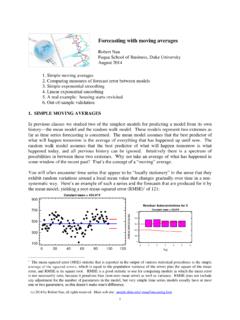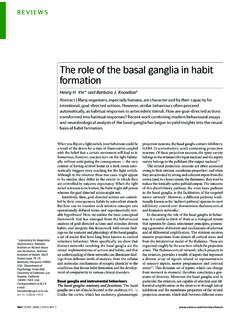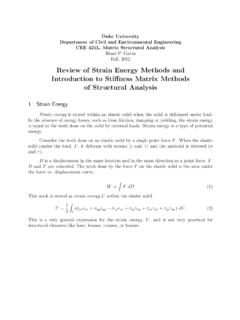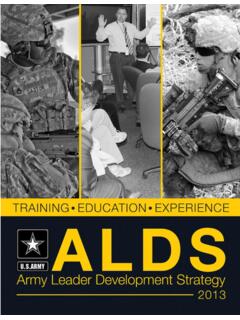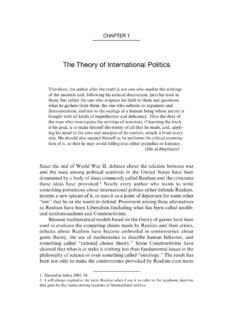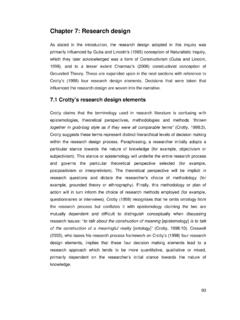Transcription of Theories of International Relations*
1 1 Theories of International Relations* Ole R. HolstiUniversities and professional associations usually are organized in ways that tend to separatescholars in adjoining disciplines and perhaps even to promote stereotypes of each other andtheir scholarly endeavors. The seemingly natural areas of scholarly convergence betweendiplomatic historians and political scientists who focus on International relations have beenunderexploited, but there are also some signs that this may be changing. These include recentessays suggesting ways in which the two disciplines can contribute to each other; a number ofprizewinning dissertations, later turned into books, by political scientists that effectivelycombine political science Theories and historical materials; collaborative efforts among scholarsin the two disciplines; interdisciplinary journals such as International Security that provide anoutlet for historians and political scientists with common interests.
2 And creation of a newsection, International History and Politics, within the American Political *The author has greatly benefited from helpful comments on earlier versions of this essay byPeter Feaver, Alexander George, Joseph Grieco, Michael Hogan, Kal Holsti, Bob Keohane,Timothy Lomperis, Roy Melbourne, James Rosenau, and Andrew Scott, and also from reading2K. J. Holsti, The Dividing Discipline: Hegemony and Diversity in International Theory(London, 1985).This essay is an effort to contribute further to an exchange of ideas between the twodisciplines by describing some of the Theories , approaches, and "models" political scientistshave used in their research on International relations during recent decades.
3 A brief essaycannot do justice to the entire range of theoretical approaches that may be found in the currentliterature, but perhaps those described here, when combined with citations of somerepresentative works, will provide diplomatic historians with a useful, if sketchy, map showingsome of the more prominent landmarks in a neighboring most enduring great debate among students and practitioners of internationalrelations has pitted realism against various challengers. Because "classical realism " is the mostvenerable and persisting theory of International relations, it provides a good starting point andbaseline for comparison with competing models. Robert Gilpin may have been engaging inhyperbole when he questioned whether our understanding of International relations hasadvanced significantly since Thucydides, but one must acknowledge that the latter's analysis ofthe Peloponnesian War includes concepts that are not foreign to contemporary students ofbalance-of-power a discussion of classical realism , an examination of modern realism or neo- realism will identify the continuities and differences between the two approaches.
4 The essaythen turns to several models that challenge one or more core premises of both classical andmodern realism . The first three challengers focus on the system level: Global-Society/Complex-3 Interdependence/Liberal-Institutionalism , Marxist/World System/Dependeny, andconstructivism. Subsequent sections discuss several decision-making models, all of whichshare a skepticism about the adequacy of Theories that focus on the structure of the internationalsystem while neglecting political processes within units that comprise the limitations should be stated at the outset. Each of the systemic and decision-making approaches described below is a composite of several models; limitations of space havemade it necessary to focus on the common denominators rather than on subtle differencesamong them.
5 This discussion will pay little attention to the second great debate, centeringmostly on methodological issues; for example, what Stanley Hoffmann called the battle of theliterates versus the numerates. 3 Efforts of some political scientists to develop "formal" ormathematical approaches to International relations are neglected here; such abstract models arelikely to be of limited interest to The post modern challenge to all other theoriesand methodologies--the third great debate --will only briefly be described and these caveats, let me turn now to classical realism , the first of the systematic models to bediscussed in this have always been Americans, such as Alexander Hamilton, who viewedinternational relations from a realist perspective, but its contemporary intellectual roots arelargely European.
6 Three important figures of the interwar period probably had the greatestimpact on American scholarship: diplomat-historian E. H. Carr, geographer Nicholas Spykman,and political theorist Hans Morgenthau. Other Europeans who have contributed significantly torealist thought include John Herz, Raymond Aron, Hedley Bull, and Martin Wight, while4notable Americans of this school include scholars Arnold Wolfers and Norman Graebner,diplomat George Kennan, journalist Walter Lippmann, and theologian Reinhold realists do not constitute a homogeneous school--any more than do any of theothers discussed in this essay--most of them share at least five core premises about internationalrelations. To begin with, they view as central questions the causes of war and the conditions ofpeace.
7 They also regard the structure of the International system as a necessary if not alwayssufficient explanation for many aspects of International relations. According to classicalrealists, "structural anarchy," or the absence of a central authority to settle disputes, is theessential feature of the contemporary system, and it gives rise to the "security dilemma":in a self-help system one nation's search for security often leaves its current and potentialadversaries insecure, any nation that strives for absolute security leaves all others in the systemabsolutely insecure, and it can provide a powerful incentive for arms races and other types ofhostile interactions. Consequently, the question of relative capabilities is a crucial to deal with this central element of the International system constitute the driving forcebehind the relations of units within the system; those that fail to cope will not survive.
8 Thus,unlike "idealists" and some "liberal internationalists," classical realists view conflict as a naturalstate of affairs rather than as a consequence that can be attributed to historical circumstances,evil leaders, flawed sociopolitical systems, or inadequate International understanding third premise that unites classical realists is their focus on geographically-based groupsas the central actors in the International system. During other periods the primary entities mayhave been city states or empires, but at least since the Treaties of Westphalia (1648), sovereignstates have been the dominant units. Classical realists also agree that state behavior is assumption behind this fourth premise is that states are guided by the logic of the "nationalinterest," usually defined in terms of survival, security, power, and relative the national interest may vary according to specific circumstances, the similarity ofmotives among nations permits the analyst to reconstruct the logic of policymakers in theirpursuit of national interests--what Morgenthau called the "rational hypothesis"--and to avoid thefallacies of concern with motives and concern with ideological preferences.
9 "6 Finally, the state can also be conceptualized as a unitary actor. Because the centralproblems for states are starkly defined by the nature of the International system, their actions areprimarily a response to external rather than domestic political forces. According to StephenKrasner, for example, the state "can be treated as an autonomous actor pursuing goalsassociated with power and the general interest of the society."7 Classical realists, however,sometimes use domestic politics, especially the alleged deficiencies of public opinion, as aresidual category to explain deviations from rational has been the dominant model of International relations during at least the pastsix decades because it seemed to provide a useful framework for understanding the collapse ofthe post-World War I International order in the face of serial aggressions in the Far East andEurope, World War II, and the Cold War.
10 Nevertheless, the classical versions articulated byMorgenthau and others have received a good deal of critical scrutiny. The critics have includedscholars who accept the basic premises of realism but who found that in at least four importantrespects these Theories lacked sufficient precision and realism has usually been grounded in a pessimistic theory of human nature, eithera theological version (for example, Saint Augustine and Reinhold Niebuhr) or a secular one (forexample, Machiavelli, Hobbes, and Morgenthau). Egoism and self-interested behavior are not6limited to a few evil or misguided leaders but are basic to homo politicus and thus are at thecore of a realist theory. But because human nature, if it means anything, is a constant ratherthan a variable, it is an unsatisfactory explanation for the full range of International relations.
